Archive Record
Images
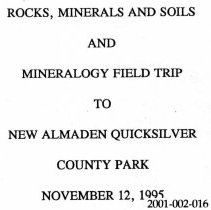
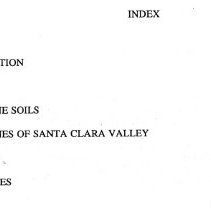
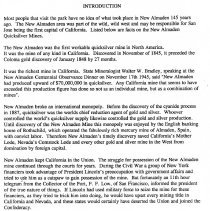
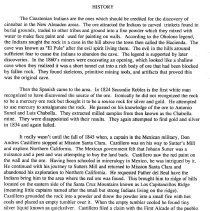
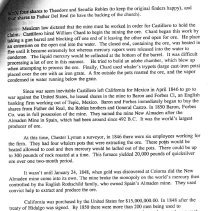
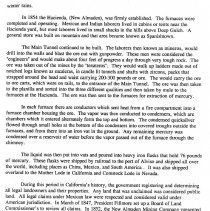
Additional Images [3]
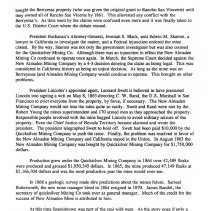
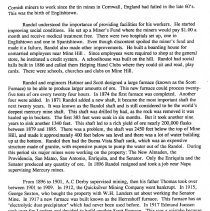
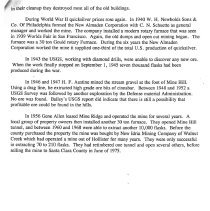
Metadata
Catalog number |
2001.1.15 |
Object Name |
Report |
Date |
1995 |
Description |
Part of a report written by Park Ranger, Tom Borra concerning New Almaden and quicksilver. The Introduction and History, pages 1 through 6 are included. Borra has attributed the History to other employees, see page 6. TITLE: Rocks Minerals and Soils SUBTITLE: Mineralogy Field Trip AUTHOR: Tom Borra ROCKS, MINERALS AND SOILS AND MINERALOGY FIELD TRIP TO NEW ALMADEN QUICKSILVER COUNTY PARK NOVEMBER 12, 1995 INDEX INTRODUCTION HISTORY 1 SERPENTINE SOILS 7 SERPENTINES OF SANTA CLARA VALLEY 8 MERCURY 13 REFERENCES 17 INTRODUCTION Most people that visit the park have no idea of what took place in New Almaden 145 years ago. The New Almaden area was part of the wild, wild west and may be responsible for San Jose being the first capital of California. Listed below are facts on the New Almaden Quicksilver Mines. The New Almaden was the first workable quicksilver mine in North America. It was the mine of any kind in California. Discovered in November of 1845, it preceded the Coloma gold discovery of January 1848 by 27 months. It was the richest mine in California. State Mineralogist Walter W. Bradley, speaking at the New Almaden Centennial Observance Dinner on November 17th 1945, said "New Almaden had produced upward of $70,000,000 in quicksilver. Any California mine that seems to have exceeded this production figure has done so not as an individual mine, but as a combination of mines". New Almaden broke an international monopoly. Before the discovery of the cyanide process in 1887, quicksilver was the world's chief reduction agent of gold and silver. Whoever controlled the world's quicksilver supply likewise controlled the gold and silver production. Until discovery of the New Almaden Mine this monopoly was enjoyed by the English banking house of Rothschild, which operated the fabulously rich mercury mine of Almaden, Spain, with convict labor. Therefore New Almaden's timely discovery saved California's Mother Lode, Nevada's Comstock Lode and every other gold and silver mine in the West from domination by foreign capital. New Almaden kept California in the Union. The struggle for possession of the New Almaden mine continued through the courts for years. During the Civil War a group of New York financiers took advantage of President Lincoln's preoccupation with government affairs and tried to use him as a catspaw to gain possession of the mine. But fortunately an 11th hour telegram from the Collector of the Port, F. F. Low, of San Francisco, informed the president of the true nature of things. If Lincoln had used military force to seize the mine for these financiers, as they tried to trick him into doing, he would have upset every mining title in California and Nevada, and these states would certainly have deserted the Union and joined the Confederacy. I hope this field guide will be helpful in historical and geologic aspects. Tom Borra Park Ranger 1995 HISTORY The Coastonian Indians are the ones which should be credited for the discovery of cinnabar in the New Almaden areas. The ore attracted the Indians to carved trinkets found in burial grounds, traded to other tribes and ground into a fine powder which they mixed with water to make face paint and used for painting on walls. According to the Oholone legend, the Indians sought the rock in a cave in the hill above the town then called the Hacienda. The cave was known as "El Pule" after the evil spirit living there. The evil in the hills aroused sufficient fear to cause the Indians to abandon the cave. The legend is supported by later discoveries. In the 1860's miners were excavating an opening, which looked like a shallow cave when they realized it was a short tunnel cut into a rich body of ore that had been blocked by fallen rock. They found skeletons, primitive mining tools, and artifacts that proved this was the original cave. Then the Spanish came to the area. In 1824 Secundio Robles is the first white man recognized to have discovered the source of the ore. Ironically he did not recognized the rock to be a mercury ore rock but thought it to be a source rock for silver and gold. He attempted to use mercury to amalgamate the rock. He passed on his knowledge of the ore to Antonio Sunol and Luis Chabolla. They extracted milled samples from then known as the Chabolla mine. They were disappointed with their results. They again attempted to find gold and silver in 1834 and again failed. It really wasn't until the fall of 1845 when, a captain in the Mexican military, Don Andres Castillero stopped at Mission Santa Clara. Castillero was on his way to Sutter's Mill and explore Northern California. The Mexican government felt that Johann Sutter was a nuisance and a pest and was attempting to buy the land back. Castillero saw the red paint on the wall and the ore. Having been schooled in mineralogy in Mexico, he was intrigued by it. He continued with his journey to Sutters Mill and returned to Mission Santa Clara and abandoned his exploration to Northern California. He requested Father del Real have the Indians bring him to the area where the red ore was found. This brought him to ridge of hills located on the eastern side of the Santa Cruz Mountains known as Los Capitancillos Ridge (meaning little captains named after the small but strong Indians living on the ridge). Castillero grounded the rock into a powder and threw the powder into a small fire with hot coals and placed an empty tumbler over it. When the empty tumbler cooled he found tiny silver liquid known as quicksilver. Castillero filed a claim with the First Alcade of the pueblo San Jose Guadalupe, to make a claim of discovery of silver and gold. On November 22, 1845. On the 3rd of December he changed his "denouncement" to the discovery of quicksilver. Then on December 30th of 1845, Antonio Pico, the First Alcalde signed the grant. Don Andres Castillero was granted possession of the first quicksilver mine in North America. He was also granted 3000 varas (A vara is anywhere from 36-42 inches) of land in all directions on the Rancho San Vincente, owned by Jose Reyes Berreyesa. The mine was called Mina de la Santa Clara. He sold twelve shares of the mine, four to General Castro (he had the army behind him) four shares to Theodore and Secudio Robles (to keep the original finders happy), and four shares to Father Del Real (to have the backing of the church). Mexican law dictated that the mine must be worked in order for Castillero to hold the claim. Castillero hired William Chard to begin the mining the ore. Chard began this work by taking a gun barrel and blocking off one end of it leaving the other end open for ore. He place an extension on the open end into the water. The closed end, containing the ore, was heated in fire until it became extremely hot whereas mercury vapors were released into the water to condense. The liquid mercury would be collected at the bottom of the barrel. It was difficult processing a lot of ore in this manner. He tried to build an adobe chamber, which blew up when attempting to process the ore. Finally, Chard used whaler's trypots (large cast-iron pots) placed over the ore with an iron grate. A fire outside the pots roasted the ore, and the vapor condensed in water running below the grate. Since war seem inevitable Castillero left California for Mexico in April 1846 to go to war against the United States, he leased shares in the mine to Baron and Forbes Cl, an English banking firm working out of Tepic, Mexico. Baron and Forbes immediately began to buy the shares from Father del Real, the Robles brothers and General Castro. In 1850 Baron, Forbes Co. was in full possession of the mine. They named the mine New Almaden after the Almaden Mine in Spain, which had been around since 492 B.C. It was the world's largest producer of ore. At this time, Chester Lyman a surveyor, in 1846 there were six employees working for the firm. They had four whalers pots that were extracting the ore. These pots would be heated allowed to cool and then mercury would be ladled out of the pots. There could be up to 300 pounds of rock roasted at a time. This furnace yielded 20,000 pounds of quicksilver ore over one two-month period. It wasn't until January 24, 1848, when gold was discovered at Coloma did the New Almaden mine come into its own. The mine broke the monopoly on the world's mercury then controlled by the English Rothschild family, who owned Spain's Almaden mine. They used convict help to extract and produce the ore. California was purchased by the United States for $15,000,000.00. In 1848 after the treaty of Hidalgo was signed. By 1850 there were more than 200 men being used to excavation of the main tunnel. A planilla, a shed, was constructed near the tunnel were rock could be sorted for roasting. The New Almaden Mining Co appointed Henry Halleck to manage the mine. He designed thirteen brick intermitted furnaces for the more efficient reduction. He had them built at what is now the Hacienda, near Alamitos Creek. It would take approximately 40 hours to process 15,000 lbs of ore in these furnaces if the grade was very good. There were three different grades. Gruesso is the purest; granzo, a medium grade tierra, the lowest quality ore, tierra was mixed with adobe and make into bricks to be processed in the furnaces in winter time when it was difficult to get to the mines due to the winter rains. In 1854 the Hacienda, (New Almaden), was firmly established. The furnaces were completed and operating. Mexican and Indian laborers lived in cabins or tents near the Hacienda yard, but most laborers lived in small shacks in the hills above Deep Gulch. A general store was built on mountain and that area became known as Spanishtown. The Main Tunnel continued to be built. The laborers then known as mineros, would drill into the walls and blast the ore out with gunpowder. These men were considered the "engineers" and would make about four feet of progress a day through very tough rock. The ore was taken out of the mines by the "tenateros". They would walk up ladders made out of notched logs known as escaleras, in candle lit tunnels and shafts with zircons, packs that strapped around the head and waist carrying 200-300 pounds or ore. The would carry the ore to ore carts, which were on rails, to the entrance of the Main Tunnel. The ore was then taken to the planilla and sorted into the three different qualities and then taken by mule to the furnaces at the Hacienda. The ore was then sent to the furnaces for extraction of mercury. In each furnace there are conductors which sent heat from a fire compartment into a furnace chamber housing the ore. The vapor was then conducted to condensers, which are chambers which it entered alternately form the top and bottom. The condensed quicksilver flowed through small holes at the bottom of the condensers into covered troughs outside the furnaces, and from there into an iron vat in the ground. Any remaining mercury was condensed over a reservoir of water before the vapor passed out of the furnace through the chimney. The liquid was then put into vats and poured into heavy iron flasks that hold 76 pounds of mercury. These flasks were shipped by railroad to the port of Alviso and shipped all over the world, including places as China, Mexico, and South America. It was also shipped overland to the Mother Lode in California and Comstock Lode in Nevada. During this period in California's history, the government registering and determining all legal landowners and their properties. Any land that was unclaimed was considered public land. All legal claims under Mexican law were respected and considered valid under American jurisdiction. In March of 1847, President Fillmore set up a Board of Land Commissioner's to review all claims. In 1852, the New Almaden Mining Company presented its claim under the name of Castillero, since he was named on the original land grant. The claim came into question by the Board. The first problem was a question as to the legality of the original Castillero grant. The United States brought suit against the New Almaden Mining Company claiming that the official documents and those pertaining to the adjoining lands were antedated and forged. The second problem was the mine property boundaries and those of adjacent land had been surveyed well. The third the Larios property had changed hands a few times, and the new owners, the Quicksilver Mining Company of Philadelphia and New York were determined to prove that the mine fell on their land. The New Almaden Mining Co had bought the Berryessa property (who was given the original grant to Rancho San Vincente) until they owned all of Rancho San Vicente by 1861. This alleviated any conflict with the Berryessa's. As time went by the claims were confused even more and it was finally taken to the U.S. District Court where the debate ensued. President Buchanan's Attorney-General, Jermiah S. Black, sent Edwin M. Stanton, a lawyer to California to investigate the matter, and a Federal injunction ordered the mine closed. By the way, Stanton was not only the government investigator but was also counsel for the Quicksilver Mining Co. Although there was an injunction in effect the New Almaden Mining Co continued to operate once again. In March, the Supreme Court decided against the New Almaden Mining Company by a 4-3 decision denying the claim as being legal. This was considered in California history as being an unjust decision. As long as the mine was on Berreyessa land Almaden Mining Company would continue to operate. This brought on other problems. President Lincolns's appointed agent, Leonard Swett is believed to have pressured Lincoln into signing a writ on May 8, 1863 directing C. W. Rand, the U.S. Marshall in San Francisco to evict everyone from the property, by force, if necessary. The New Almaden Mining Company would not lose the mine quite so easily. Swett and Rand were met by the Robert Young the mines superintendent and 170 armed men as they approached the property. Responsible people involved with the mine begged Lincoln to avoid military seizure of the property. Even the Chief Justice of Nevada Territory became alarmed and wrote the president. The president telegraphed Swett to hold off. Swett had been paid $10,000 by the Quicksilver Mining Company to push the issue. Finally, the problem was resolved in favor of the New Almaden Mining Company and California stayed in the Union. In August 1863 the New Almaden Mining Company was bought by Quicksilver Mining Company for $1,750,000 dollars. Production grew under the Quicksilver Mining Company in 1864 over 42,489 flasks were produced and grossed $1,950,345 dollars. In 1865, the mine produced 47,149 flasks at $2,166,304 dollars and was the most productive year the mine would ever see. In 1868 a geologic survey made dire predictions about the mines future. Samuel Butterworth, the new mine manager hired in 1864 resigned in 1870. James Randol, the secretary of Quicksilver Mining Co took over as general manager. Much of the credit for the success of New Almaden Mine is attributed to him. At this time Spanishtown was part of the real wild west. As the story goes if only a couple people died on payday it was a slow day on the hill. When Randol took over this ended. He attempted to kick everyone off the hill that did not do business with Quicksilver Mining company. There is a story of a gambler who refused to leave because he said that he owned his own home. Randol hired a couple of carpenters, sawed down the house and took it off the property and left in pieces. The gambler ended up leaving. Randol encouraged the Cornish miners to work since the tin mines in Cornwall, England had failed in the late 60' s. This was the birth of Englishtown. Randol understood the importance of providing facilities for his workers. He started improving social conditions. He set up a Miner's Fund where the miners would pay $1.00 a month and receive medical treatment free. There were two hospitals set up, one in Englishtown and one in Spanishtown. Even though discontent spoiled the miner's fund and made it a failure, Randol also made other improvements. He built a boarding house for unmarried employees near Mine Hill . Since employees were required to shop at the general store, he instituted a credit system. A schoolhouse was built on the hill. Randol had social halls built in 1886 and called them Helping Hand Clubs where they could sit and read, play cards. There were schools, churches and clubs on Mine Hill. Randol and engineers Huttner and Scott designed a large furnace (known as the Scott Furnace) to be able to produce larger amounts of ore. This new furnace could process twenty-five tons of ore every twenty four hours. In 1874 the first furnace was completed. Another four were added. In 1871 Randol added a new shaft, it became the most important shaft the next twenty years. It was known as the Randol shaft and is still considered to be the world's deepest mercury mine shaft. This shaft was drilled by had, as the rock was removed it was hauled up in buckets. The first 383 feet were sunk in six months. But it took another nine years to sink another 1340 feet. This shaft led to a rich yield of ore nearly 200,000 flasks between 1879 and 1895. There was a problem, the shaft was 2450 feet below the top of Mine Hill, and made it approximately 400 feet below sea level and there was a lot of water building up at the bottom. Randol then had the Buena Vista Shaft sunk, which was an expensive structure made of granite, with expensive pumps to pump the water out of the Randol. During this period six major mines were working on the property: The New Almaden, the Providencia, San Mateo, San Antonio, Enriquita, and the Senator. Only the Enriquita and the Senator produced any quantity of ore. In 1896 Randol resigned and took a job near Napa supervising Mercury mines. From 1896 to 1901, A. C Derby supervised mining, then his father Thomas took over between 1901 to 1909. In 1912, the Quicksilver Mining Company went bankrupt. In 1915, George Sexton, who bought the property with W.H. Landers set about working the Senator Mine. In 1917 a new furnace was built known as the Herreshoff furnace. This furnace has an "electrolytic dust precipitator" which had never been used before. In 1917 Edmund Juessen took over for Landers and decided to build another Scott Furnace. This was a mistake because the Herreshoff furnace was working to full capacity. In 1926 when Sexton died, the property was inherited by Mrs. Mary Lord Sexton. She leased the property from 1928-1935 to various miners who extracted some quicksilver from old dumps and from under the old furnaces. In 1935 Geologist C. N. Schuette and caretaker Jimmie Schneider made a report on mine conditions, concluding that the mine still had potential. Also during the 1930's the CCC made camp in the Old Englishtown. Unfortunately in their cleanup they destroyed most all of the old buildings. During World War II quicksilver prices rose again. In 1940 W. H. Newbolds Sons & Co. Of Philadelphia formed the New Almaden Corporation with C. N. Schuette as general manager and worked the mine. The company installed a modern rotary furnace that was seen in 1939 Worlds Fair in San Francisco. Again, the old dumps and open cut mining began. The furnace was a 30 ton Gould rotary Furnace. During the six years the New Almaden Corporation worked the mine it supplied one-third of the total U.S. production of quicksilver. In 1943 the USGS, working with diamond drills, were unable to discover any new ore. When the work finally stopped on September 1, 1945 seven thousand flasks had been produced during the war. In 1946 and 1947 H. F. Austine mined the stream gravel at the foot of Mine Hill. Using a drag line, he extracted high grade ore bits of cinnabar. Between 1948 and 1952 a USGS Survey was followed by another exploration by the Defense material Administration. No ore was found. Bailey's USGS report did indicate that there is still a possibility that profitable ore could be found in the hills. In 1956 Gene Allen leased Mine Ridge and operated the mine for several years. A local group of property owners then installed another 30 ton furnace. They opened Mine Hill tunnel, and between 1960 and 1968 were able to extract another 10,000 flasks. Before the county purchased the property the mine was bought by New Idria Mining Company of Walnut Creek which had operated a mine out of Hollister for many years. They were only successful in extracting 70 to 210 flasks. They had retimbered one tunnel and open several others, before selling the mine to Santa Clara County in June of 1975. Most of the history provided by historical Resources of Almaden Quicksilver Park done by a Student Aide Anne L. Lyness and Felice Errico Park Planner. This material researched in 1978. |
People |
Borra, Tom Castillero, Andres Castro, Augustin M Chabolla, Luis Chard, William G. Huttner, H.J. Lincoln, Abraham Lyman, Chester Smith Robles, Secundino Sunol, Antonio |
Pub Place |
New Almaden Quicksilver County Park |
Cataloged by |
Boudreault, Art |
Collection |
Anonymous/Unknown 1 |
